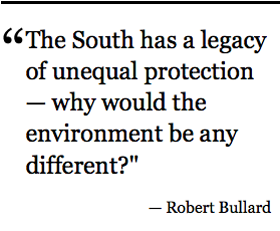 Wilma Subra, a diminutive grandmother, has long challenged the corporate polluters in one of the nation’s most toxic regions
Wilma Subra, a diminutive grandmother, has long challenged the corporate polluters in one of the nation’s most toxic regions
By JULIE CART
Reporting from NEW IBERIA, LA.
August 27, 2013
[dropcap]T[/dropcap]he police asked the right question.
“Can you think of anyone who would want to do you harm?” investigators asked Wilma Subra, trying to understand who might have fired a gun at the diminutive grandmother.
Enemies?
Subra could arrange them alphabetically, or geographically, or in descending order according to how much her work as an environmental chemist had cost them in money or public embarrassment.
She had gone after so many corporate polluters over the decades, the question had just too many possible responses.
Authorities never found the person who shot at her while she was working at her desk by the front window. The soft-spoken crusader’s response to the threat was to put bars on her windows, move her desk to the back of the house — and keep going.
Seven years later, at 69, Subra is still working to rein in environmental degradation along Cancer Alley, an eye-watering corridor of more than 150 industrial facilities along the Mississippi River between New Orleans and Baton Rouge that produce a quarter of the nation’s petrochemicals.
The South has a legacy of unequal protection — why would the environment be any different?”
She’s a winner of a MacArthur “Genius grant” who totes her grandchildren to public hearings, giving them crayons to scribble on the back of scientific papers. She’s a fighter who has taken on refineries, chemical manufacturers and oil and gas companies, including BP over its cleanup of the Gulf of Mexico oil spill in 2010.
Most important, admirers say, she’s a dedicated enabler, teaching people in some of the nation’s poorest communities to help themselves by using the latest technology to track air and water quality in their own backyards.
“What separates Wilma from other scientists is she’s taking it to the next step, allowing communities to have a voice,” said Robert Bullard, author of “Dumping in Dixie,” a book about the South’s toxic environmental legacy. “She makes real change on the ground.”
Subra has lived in the oil patch her whole life. When she bumps into people she grew up with or attends class reunions with her husband, Clint, she sees two sets of people in the room:

Wilma Subra fights polluters along Cancer Alley, a corridor of more than 150 industrial facilities along the Mississippi River. (Brad Kemp / Lafayette Daily Advertiser).
“The ones who look their age and the ones who look so old. The old-looking ones work in oil and gas or the chemical plants. You can clearly see the difference — the pallor of their skin, how shriveled.”
Subra understands that people here live near chemical plants because they don’t have the money to leave, and the workers won’t leave because of the money they can make.
An oil refinery spews smoke in Baton Rouge. (Jerry Grayson / Helifilms Australia) More photos
“They enjoy the income, because they can hunt, they can fish, they can go to LSU games and have big-screen TVs and campers and all this,” she said.
They also know the work can be damaging to their health.
“The guys who work in the plants will tell you they know it killed their dad,” she said. “They know it killed their mom because the dad came home with contaminated clothing and the mom washed the clothes.
To read complete story click here […]







